| content | about | pitch | subscribe | find | advertise | mouthoff |
| primagallerina's oralreport our secret agent explores life on the other side of the wall photos by liz nielsen and julie farstad |
  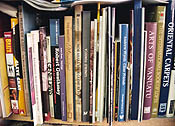 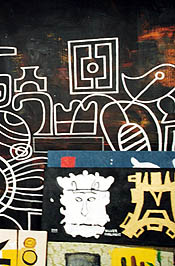 Top: Bernard Williams, Malinke, acrylic on paper, 40x40 in., 2002. Courtesy the artist. | Bernard Williams Artist statement: I'm real interested in collecting things. Rep: Jan Cicero Gallery, Chicago; G. R. N'Namdi Gallery, Detroit. Neighborhood: West Humboldt Park. Day or night person? Both. Can't work without: Music. Space. Books that feature objects from nonwestern cultures. Gotta have some paint. I'm painting on fabric and canvas right now, and doing some construction things with wood. I need to have some power tools--the drill and the scroll saw have been pretty active recently. I'm also a big cookie person. Background noise: Everything from hip-hop, r&b, jazz. We've got Brazilian sounds going right now. A certain amount of what we do is painful and monotonous, so anything that can relieve some of that other than drugs. Music for me is the natural drug. Generally I like a dance beat; slow music won't keep me excited. For me, it's about creating a fairly exciting atmosphere because my work is very physical. It's like a dance--dancing between canvases. Significant object and its history: I got a box of letters from the '70s by and to a well-known Chicago artist. I found them in a dumpster--they were about to get pitched. I contemplated returning them, but I figured, why? I mean, he's been living without them for this long. Creative block coping strategy: The books help--a lot. I've been working on these fabrics lately, and I think getting away from traditional materials has liberated a good bit of my creativity, so I feel less constrained by preparing the canvas the way it ought to be prepared. You know, following all the art rules. I don't feel like I've suffered from that much. I hope I never do. What is the relationship between the space you work in and the work you make? I've always been interested in having some open space. When I was a student, I was making big paintings and really stressing the amount of space that I had in school. So it has always been important to have a pretty large wall that I can get a big canvas on. That requirement or desire has had an impact on the spaces I've considered; for example, I wouldn't really consider a house. It would be hard for me to do what I do in most houses. I'm interested in warehouse buildings, so I think I've gravitated toward that. How does being in this raw space, where you go out into the hall and see all of this industrial equipment, affect you? I think these places end up being dirty and dusty, and that kind of rubs off on the work. I've embraced a certain amount of dirt and scratches and smears. It's a by-product of where I live. When you're not worried about the surface as much, you're willing to inflict a certain amount of damage intentionally. I can get paint on the floor and nobody's really gonna say much. And I think some of the objects I see coming in and out of the building influence my work. The marble cutters downstairs, with these big sheets of heavy material...you start to wonder--is there a way for me to use that? Has it made you become more sculptural? Yeah, it has certainly fostered it. It's really nice to see these guys moving those heavy objects around, too, because it gives me a sense of what I'll be involved in as I make larger and larger things. For me, it's really training ground in a way. And I've actually acquired some of their stuff; I'll grab a piece of marble or something if they're throwing it away. I see some of their processes becoming my own processes. Notable studio mishap: In the past, I've had leaks over certain areas, though nothing has gotten on the paintings. But there have been a few nights when it's dripping and I'm trying to go to bed, and it's the most annoying, irritating situation. How do you unwind at the end of a long day/night in the studio? I like heading straight to Wicker Park. The Subterranean is always good; I like their hip-hop nights. Myopic Bookstore is one of my favorite escapes; they're open all night. I've had plenty of midnight visits--11 p.m., you can find me. |
   Top: Claire Pentecost, Big Curls, palladium print, 10x8 in., 2000-01. Courtesy the artist. | Claire Pentecost Artist statement: My work explores the shifting boundary between the natural and the artificial. Rep: I've shown at Jean Albano Gallery, Chicago, and most recently at the Corcoran Gallery, Washington, D.C., with a piece that is documented on their website. Also, I just published an article on food, knowledge, authority, and the role of the artist in Art Journal. Neighborhood: I think realtors want to call it West Bucktown. One SAIC student called this neighborhood "the faculty ghetto." Day or night person? Well, I was always a night person, until I started teaching and then I had to get up early. One of my favorite times is still at night, but I have adapted to adulthood. When things really get rolling, it's usually during that kind of nighttime that feels sort of endless. Can't work without: Music. Good, organic, fair-trade coffee and yerba mate, which is an herb you should drink out of a gourd--but I can't deal with the gourd--and sip it through a straw with a strainer at the bottom. Also pencil, charcoal, chalk, rapidographs. Background noise: For most of the stuff I do, I like to have music on. Anything from Sleater-Kinney, Sonic Youth, a Persian-Indian band called Ghazal, to opera, folk, classical, rap, and Baroque singing. I need variety. Significant object and its history: Pick one: Rotted fruit and vegetable peels, rubber ears and noses, random packaging, fragments of toy arms, brain coral, genetically engineered tomato paste, a box of snake skins, player-piano music, books, newspapers, an old pan to make madeleines in, false eyelashes, bones, tongues that stick to the walls, Mammowipe for general washing and patient skin-cleansing. Creative block coping strategy: I'll look at the stuff I've collected, or I'll read. But I also keep notes when I'm on a roll and I have a lot of ideas. Often what helps me is going back to something I wanted to do and didn't have time for. But the most important thing is just starting on the barest thread, entering the process--then it will take care of itself. It's just taking that risk. What is the relationship between the space you work in and the work you make? I had a hard time finding a studio, so I finally decided to just rent a rundown apartment. I told them, "I'm drawing on the walls; don't fix it up." I turned one of the rooms into a darkroom, and wash my prints in the tub. I draw on the walls, stopping at different stages to make an 8x10 negative, and then make palladium prints. The work that I'm doing here is very specific to this space, because I'm exploring the experience of interiority and using a domestic interior as a metaphoric setting. I was educated to develop my interior life. That's a modernist subject. But in the postmodern era, I often ask myself, who cares about all this precious interiority? There's so much out there in the world to address, and it's hard to know how your interior life and the processes of your unconscious relate to things outside. So the studio is kind of a model for exploring that interior life, where I can allow myself to make decisions that are not rational, that are based on a hunch or an association. I still think that's a viable base for individual autonomy. I get very attached to the space, because it's really where this work happens. The studio works as a metaphor for the mind; things float in from the outside via ads or newspapers or the radio, mingle with something from memory, and combine in a drawing. And the audience never goes to the studio; they get a representation of what goes on in there, or in the mind; the work is a photograph of that process. I sometimes conceive of it as brokering the public and the private--notions that are currently in transition. Notable studio mishap: I think my worst mishaps are my own projects. I'll be working like mad on something, and everything gets moved or harnessed. Then the project's over and the studio looks like a tornado went through it, because when I'm working, I don't put anything away. If it doesn't work over there, I start again over here...it's like this trail of all my trial and error. How do you unwind at the end of a long day/night in the studio? Alcohol and TV. Or in my better phases, yoga. |
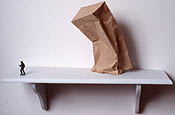 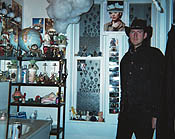 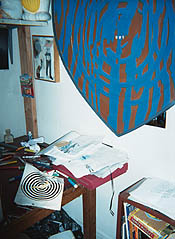 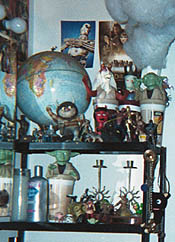 Top: Duncan R. Anderson, Run, Klaus! (The Void), figurine, paper bag, shelf, 14x22x7 in., 2000. Courtesy the artist. | Duncan R. Anderson Artist statement: It's somewhat of an anecdote from a different generation. My father was a Marine in World War II, and I remember at Christmastime a few years ago, I was coming home from a night out, and he was sitting there in a very serious mood. I said, "You were 21 and leading men through the most horrible things they would ever see, and here I am going through my room for change to buy a six-pack of something cheap so I can work in the studio." But it was the oddest thing: in all sincerity, he said, "Well, Dunky, I guess that's what we did it for, so fellas like you and your friends could paint, and write symphonies, and make beautiful things." He's incredibly supportive of me. East Tennessee is very much wrapped up in a great deal of my work. In many respects, one of the most important elements in my work is the notion of the wild woods. It's interesting that my dad picks up on that as well. Rep: I was represented by Arena Gallery until they unfortunately closed down, so I'm currently independent. Among other things, I'm working on events and exhibitions with Collaboraction, and I'll be co-curating a show with Kimberly Aubuchon at Unit B gallery in Pilsen in February. Neighborhood: Ukrainian Village. Day or night person? It usually depends on the project. When I'm drawing and working out ideas, it's all night, but when I've got to fabricate and do technical stuff, it's usually daytime. Can't work without: Beer and Skoal, unfortunately. I am from East Tennessee. Background noise: My good friend Matthew made me these compilation CDs, because, left to my own devices, I'd listen to classic country, XTC, The Smiths, and art-school stuff. I'm not into music--I don't get out to music stores and explore--so all four changers in my CD player are filled by these mixes he made for me. It exposes me to a lot of stuff. Significant object and its history: One of my giant artistic revelations back in school was running across Robert Motherwell's Dada Poets and Painters. I was 20 years old, and it just blew the doors off everything. And for some reason I also seized on this image here on my work table--Optophone by Francis Picabia--and a reproduction of it has been a totem in my studio ever since. Creative block coping strategy: Even when you don't feel like it's there, you make yourself do it. If you've been drawing every day for four months, you're gonna draw a lot better that next day than if you've had this block for four months. It's like your hand remembers when your head doesn't. It's never worthless, because you never know when something comes out. Some of the best stuff you get is when you are working, trying to push through, and something shows up out of the blue. What is the relationship between the space you work in and the work you make? I've always been fond of combining my living spaces with my working spaces, because for me, the way I work, it's like, "The Simpsons are just about over, and I gotta go to bed, I gotta be at work at 7 a.m."--and then I think, "Oh, I know exactly what to do!" And I walk straight into the studio. I've also always been a big fan of sleeping with at least one sketchbook, because invariably I dream about work, or I dream solutions. It's a great thing to wake up and go, "Oh yeah!" and sketch out the idea. I like that I sleep in a loft above my workspace because I can actually look down at a piece at night, or scramble down and go, "You go here!" Or make a quick note: "Tomorrow morning, cut this off." I'd love for a separate room in the apartment to be the workspace, but I'm not a big fan of going to the studio like it's going to a second job. For me, the scale of the studio might affect the scale of the work, but not the scale of the ideas. Notable studio mishap: On a daily basis? I was learning about motors, which I love and put in all kinds of different things, and voltages, and I didn't know that some are compatible with your house and some are not. I plugged one in, and it managed to erupt in flame and acrid smoke, which engulfed the apartment. It was astonishing, and I just stood there aghast. My roommate Daniel came running in and threatened, "You can't work with motors anymore until you figure this shit out! 'Cause you're gonna kill yourself and us!" How do you unwind at the end of a long day/night in the studio? I usually reward myself by watching Star Wars or reading any number of Tolkien books. |
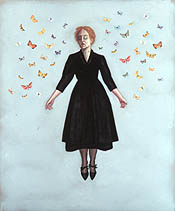 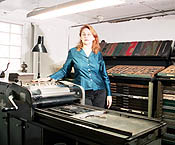 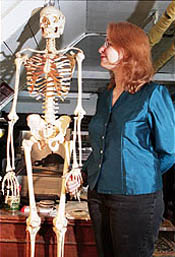 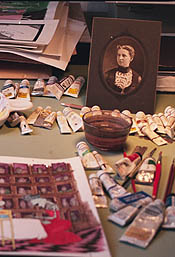 Top: Audrey Niffenegger, A Dream of Flying with Butterflies, charcoal, pastel, collage on paper, 48x32 in., 2000. Courtesy Printworks Gallery, Chicago. | Audrey Niffenegger Artist statement: My work is narrative and figurative, and most of the time I'm telling stories about girls in trouble. Rep: Printworks Gallery, Chicago. I've also written a novel, The Time Traveler's Wife--hopefully, it will be in bookstores sometime this year. Neighborhood: The middle of nowhere. The official name is North Park. Day or night person? Well, like a lot of other people, I have a job--I'm a professor at Columbia College and all my classes are at night. And even though I would ordinarily prefer to be a night person in the studio, I am a day person by force. Can't work without: I suppose the irreducible thing would be ink. Coca-cola is also always a good thing. Background noise: I can't listen to music when I write, but it is essential when you're making visual things. I think that has a lot to do with the part of the brain you're using. I listen to punk. I'm a huge Iggy Pop fan. Also Sleater-Kinney, Golden Palominos, and--this is really not punk--Joni Mitchell. Do you sing along? Oh yeah, you have to. The Ramones are also good for jumping around. Significant object and its history: This little photograph that's sitting over here is my great aunt Dulcie. I only met her once when I was a child, and she was a really old lady riding a tractor. But I inherited a whole pile of furniture from her, along with bushels of photographs from her family, who are not my relations. So I kind of use these photographs to amuse myself and give writing exercises to students and stuff. She's sort of become like a little studio goddess. When I go to Ragdale in the summertime, I actually bring her with me. I've had that photo for at least 10 or 15 years. Creative block coping strategy: I have the opposite problem because my life is so very busy. The problem, in fact, is getting into the studio, not being blocked once I get there. That would almost be a huge luxury, because it would mean that I was in the studio so much that I had run out of ideas, and I just haven't been able to achieve that kind of lifestyle. What is the relationship between the space you work in and the work you make? I think it's very important, because I know a lot of people who would like to work really huge but have a really tiny space, or they would like to do a certain technique but they don't have access to that equipment. For me, it's been really important to have my own equipment, because some of the stuff I do is a little obscure--like letterpress. It's sort of ironic, because I work at the Center for Book and Paper Arts, and they have everything you could conceivably want to make any kind of bookwork. But it's almost Marxist--it's important to have the means of production, so that nobody can stop you from doing whatever you need to do. Did your work change when you moved your studio into your house? When I moved into the house I was writing my novel, and it just got easier and easier to write the novel, and harder and harder to get myself to do anything in the studio. There was period of about a year and a half when I didn't make any visual work at all, really. Notable studio mishap: I used to share space with Pamela Barrie, who is another book artist, and through no fault of our own, we had a fire. One afternoon, I walked in to work on something, and the whole space was covered with this white powder. I went and asked another guy who rented the space, and he said, "Oh, you had a fire." Apparently, the janitor of the building had been smoking, and when he was done with the cigarette he just flicked it out the window. But the windows had grids over them, so instead of the cigarette going onto the street, it rolled down the grid under the windowsill, which was wood. Of course we weren't there, so somebody smelled smoke and called the fire department. They came in, in full gear with axes and fire extinguishers, and put out the flame. Imagine: cases and cases of type, and all of it covered with this fire extinguisher shit. And it tastes so nasty in your mouth. How do you unwind at the end of a long day/night in the studio? Oh, I take a bath. |